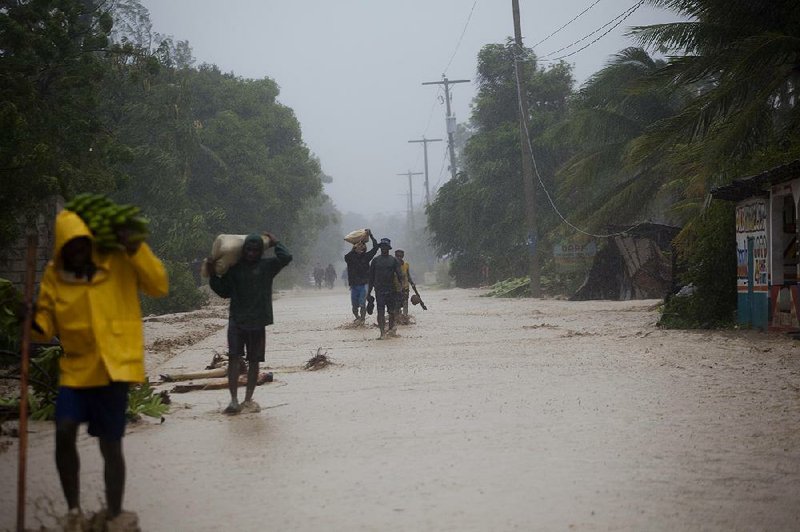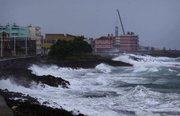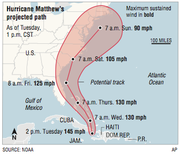PETIT-GOAVE, Haiti -- Hurricane Matthew slammed into Haiti's southwestern tip with howling, 145 mph winds Tuesday, tearing off roofs in the poor and largely rural area, uprooting trees and leaving rivers bloated and choked with debris.
By nightfall, at least 11 deaths had been blamed on the powerful storm during its weeklong march across the Caribbean. But with a key bridge washed out, impassable roads and phone communication cut off with Haiti's hardest-hit area, there was no way to know how many people might be dead or injured.
The storm whipped at Cuba's sparsely populated eastern tip Tuesday night, as it headed for a two-day run up the length of the Bahamas that would take it near the U.S. coast. The forecast triggered a rush by Americans to stock up on food, gasoline and other emergency supplies.
Twenty-foot waves pounded the seafront promenade in the Cuban town of Baracoa. Powerful winds rattled the walls of homes and heavy rain caused some flooding. But state media said late Tuesday that there were no immediate reports of serious damage.
[HURRICANE TRACKER: Follow Hurricane Matthew's path so far, projected course]
The Category 4 storm -- at one point the most powerful hurricane in the region in nearly a decade -- blew ashore around dawn in the poorest country in the Western Hemisphere, hitting a corner of Haiti where many people live in shacks of wood or concrete blocks.
Damage in the hardest-hit part of Haiti appeared to be widespread, but the full extent was not immediately clear.
The country's Civil Protection Agency said many homes were ruined.
"It's much too early to know how bad things are, but we do know there are a lot of houses that have been destroyed or damaged in the south," said Marie Alta Jean-Baptiste, the agency's director.
"It's the worst hurricane that I've seen during my life," said Fidele Nicolas, a civil protection official in Nippes, just east of where Matthew went ashore. "It destroyed schools, roads, other structures."
Mourad Wahba, the United Nations secretary-general's deputy special representative for Haiti, said much of the local population had been forced from their homes, at least 10,000 people were in shelters and hospitals were overflowing and running short of water. The roof was blown off the hospital in the city of Les Cayes, he added.
Wahba's statement called the hurricane's destruction the "largest humanitarian event" in Haiti since the devastating earthquake of January 2010.
At least five deaths were blamed on the storm in Haiti, including a 26-year-old man who drowned trying to rescue a child who fell into a rushing river, authorities said. The child was saved. The mayor in flooded Petit Goave reported that two people died there, including a woman who was killed by a falling electrical pole.
Four deaths were recorded in the neighboring Dominican Republic and one each in Colombia and in St. Vincent and the Grenadines.
The storm left the peninsula that runs along the southern coast of Haiti cut off from the rest of the country. Many streets were impassable because of flooding, landslides or fallen trees. Area radio reported that the water was shoulder high in parts of Les Cayes.
Milriste Nelson, a 65-year-old farmer in the town of Leogane, said his neighbors fled when the wind ripped the corrugated metal roof from their home. His own small yard was strewn with the fruit he depends on for his livelihood.
"All the banana trees, all the mangoes, everything is gone," Nelson said as he boiled breadfruit over a charcoal fire in the gray morning light. "This country is going to fall deeper into misery."
Haitian authorities had tried to evacuate people from the most vulnerable areas ahead of the storm, but many were reluctant to leave their homes. Some sought shelter only after the worst was already upon them.
"Many people are now asking for help, but it's too late because there is no way to go evacuate them," said Fonie Pierre, director of Catholic Relief Services for the Les Cayes area, who was huddled in her office with about 20 people.
Matthew was expected to bring 15 to 25 inches of rain, and up to 40 inches in isolated places across the country, along with up to 10 feet of storm surge and battering waves.
Images posted on social media Tuesday showed raging, muddy floodwaters nearly overflowing river banks, and driving wind and rain that bent palm trees nearly in half. The winds sheared roofs from ramshackle houses, uprooted trees, washed out bridges and clogged rivers and roads with debris.
In one video, a man shouted in English, "Pray for us," as Matthew lashed Les Cayes. A major concern in such low-lying areas is the persistent danger from flooding and mudslides, relief officials said.
The United Nations Children's Fund warned that more than 4 million children were at risk in Haiti.
"This is the worst storm Haiti has seen in decades, and the damage will no doubt be significant," Marc Vincent, UNICEF's representative in Haiti, said in a statement. "Waterborne diseases are the first threat to children in similar situations -- our first priority is to make sure children have enough safe water."
Haitian authorities called on the peacekeepers of the U.N. Stabilization Mission in Haiti to assist in the response to the hurricane, said Ariane Quentier, a spokesman for the mission. But with the storm still raging, there was little they could do.
"We're also waiting for the rain and the wind to stop," Quentier said by phone from Port-au-Prince.
Matthew is the strongest Caribbean hurricane in nearly a decade and the most powerful to hit Haiti in 52 years, when Hurricane Cleo struck in the same location. Matthew also triggered warnings and watches for parts of Jamaica and the Turks and Caicos Islands.
U.S. defense officials said Tuesday that the Pentagon is ready to dispatch at least three Navy ships and a detachment of military helicopters to assist any Caribbean countries hit by the hurricane.
The Pentagon also will move a detachment of nine U.S. military helicopters from Honduras to the Cayman Islands in anticipation of possible hurricane response efforts, Pentagon spokesman Peter Cook said. The move puts them within a few hundred miles of Jamaica, Cuba and Haiti. U.S. Southern Command, with headquarters in Miami, also will establish a joint task force commanded by Rear Adm. Cedric Pringle in anticipation of requests for help.
"This is a serious storm, and while we have not received any specific request for assistance at this point, we do stand ready to provide support in the region as needed," Cook said.
Cuba, Florida
Matthew briefly reached the top classification, Category 5, as it moved across the Caribbean late last week, becoming the strongest hurricane in the region since Felix in 2007.
As of 7 p.m. Central time, the storm's center was making landfall near Cuba's sparsely populated eastern tip. It was moving north at close to 9 mph with sustained winds at 140 mph.
The center was projected to pass about 50 miles northeast of the U.S. naval base at Guantanamo Bay, Cuba, where the Navy evacuated about 700 spouses and children of service members.
Workers removed traffic lights from poles in the Cuban city of Santiago to keep them from getting blown away.
In the U.S., Florida Gov. Rick Scott urged coastal residents to prepare for the possibility of a direct hit and line up three days' worth of food, water and medicine. Scott declared a state of emergency, activated 200 National Guardsmen and put 6,000 more on standby.
"Once this storm comes. we cannot put our first responders in harm's way," he said. "You must leave before it's too late. You can rebuild a home; you can rebuild a business; you cannot rebuild a life."
He added: "We have to be prepared to be hit by a catastrophic hurricane." A direct hit, he said, could bring "massive destruction we haven't seen in years."
The Red Cross put out a call for volunteers in South Carolina. And the White House said relief supplies were being moved to emergency staging areas in the Southeast.
"We do not know yet whether the center of Matthew will actually come ashore in Florida. That's possible," said Rick Knabb, director of the hurricane center.
The governors in Florida, Georgia, South Carolina and North Carolina declared states of emergency. President Barack Obama canceled today's campaign and health care events in Florida and will instead visit the headquarters of the Federal Emergency Management Agency.
South Carolina Gov. Nikki Haley said she would issue an evacuation order for coastal communities today so that 1 million people would have time to leave the coast. She said evacuees should move at least 100 miles inland today.
"We've been through winter storms. We've been through a 1,000-year flood. A hurricane is different. I don't want anyone to look at the last couple of tragedies we've gone through and think this is similar," Haley said.
Americans raced to supermarkets, gas stations and hardware stores, buying up groceries, water, plywood, tarps, batteries and propane.
In South Florida, lines at grocery stores were heavier than usual and some essentials were in short supply. When Simone Corrado and her husband tried to buy water at their Publix in Davie near Fort Lauderdale, they mostly found empty shelves. There were a few bottles of high-end water brands, but there was so much empty shelf space that Corrado lay down and fully stretched out on the bottom shelf.
"I got scared because all that was left at Publix was just the pricey water," said Corrado, who lived through 1992's Hurricane Andrew, which practically leveled the nearby city of Homestead. "They really put the fear into you here. On the television screen every few minutes is the 'beep, beep, beep' storm alert."
Dane Vaala, a diesel mechanic, was loading plywood onto his pickup. He needed it so he could stand on his awning to install upper floor shutters at his home. He moved to Florida from Montana in 2007, so Matthew would be his first storm. He had loaded up on canned food and water.
"I'm not too concerned -- it doesn't really bother me much," he said. "But it is better to prep."
Information for this article was contributed by David McFadden, Ben Fox, Jennifer Kay, Danica Coto, Terry Spencer, Jeffrey Collins, Mike Schneider, Freida Frisaro and Martha Waggoner of The Associated Press and by William Branigin, David Filipov and Dan Lamothe of The Washington Post.
A Section on 10/05/2016



